The programmable controller is a digital arithmetic operating electronic system designed for applications in industrial environments. It uses a programmable memory to store operational instructions such as logic operations, sequence control, timing, counting, and arithmetic operations, and to control various types of machinery or through digital, analog inputs and outputs. production process. Programmable controllers and their associated peripherals should be designed in a way that is easy to integrate with the industrial control system and easily expand its functionality.
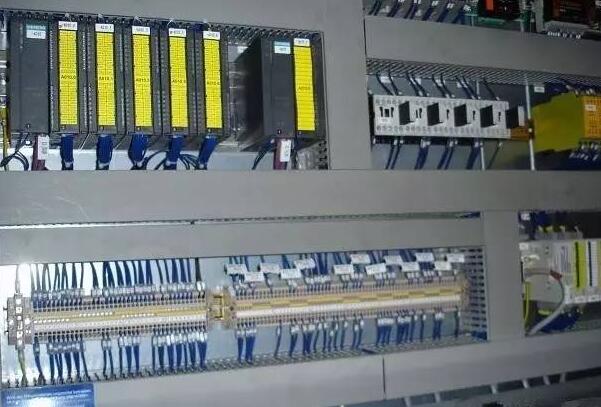
2. Classification of PLC
There are many types of PLC products, and their specifications and performance are also different. For PLCs, they are generally classified according to their structural forms, functional differences, and number of I/O points.
2.1. Classification by structure
According to the structure of the PLC, the PLC can be divided into two types: integral and modular.
(1) Integrated PLC
The integrated PLC is to install the power, CPU, I / O interface and other components in a single chassis, as shown. It has the characteristics of compact structure, small size and low price. Small PLCs generally use this monolithic structure. The integrated PLC consists of a basic unit (also called a host) and an expansion unit with different I/O points. The basic unit has a CPU, an I/O interface, an expansion port connected to the I/O expansion unit, and a write to the programmer or EPROM. Interfaces connected to the device, etc.; only the I/O and power supplies in the expansion unit, and no CPU. The base unit and the expansion unit are usually connected by a flat cable. Integral PLCs can also be equipped with special functional units, such as analog units, position control units, etc., to extend their functionality.

(2) Modular PLC
The modular PLC makes each component of the PLC into several separate modules, such as a CPU module, an I/O module, a power module (some are included in the CPU module), and various functional modules. The modular PLC consists of a frame or substrate and various modules mounted on the socket of the frame or substrate as shown. This modular PLC features flexible configuration, can be equipped with different scale systems according to needs, and is easy to assemble, easy to expand and repair. Large and medium-sized PLCs generally adopt a modular structure.
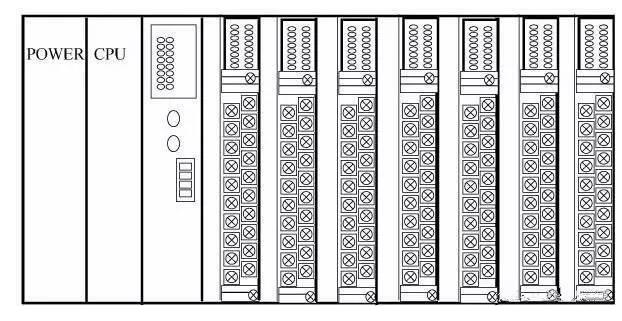
There are also PLCs that combine the characteristics of monolithic and modular to form a so-called stacked PLC. The CPU, power supply, I/O interface, etc. of the stacked PLC are also independent modules, but they are connected by cables, and the modules can be stacked one on another. In this way, not only can the system be flexibly configured, but it can also be made compact.
2.2. Classification by function
According to the different functions of the PLC, the PLC can be divided into three categories: low-end, mid-range and high-grade.
(1) low-end PLC
Low-end PLC has basic functions such as logic operation, timing, counting, shifting, self-diagnosis, monitoring, etc. It can also have a small number of analog input/output, arithmetic operations, data transfer, comparison and communication functions, mainly used for logic control and sequence. Single-machine control system with control or a small amount of analog control.
(2) Mid-range PLC
In addition to the functions of low-end PLC, mid-range PLC also has strong analog input/output, arithmetic operation, data transmission and comparison, digital system conversion, remote I/O, subroutine and communication networking; some can be added. Interrupt control, PID control and other functions for complex control systems.
(3) High-end PLC
In addition to the functions of the mid-range PLC, the high-end PLC also adds the functions of signed arithmetic operations, matrix operations, bit logic operations, square root operations and other special function functions, tabulation and table transfer functions. High-end PLCs have stronger communication networking functions, which can be used for large-scale process control or to form a distributed network control system to achieve factory automation.
2.3. Sort by I/O points
According to the number of I/O points of the PLC, the PLC can be divided into three categories: small, medium and large.
(1) Small PLC
The small PLC has less than 256 I/O points and has a single CPU and an 8-bit or 16-bit processor. The user memory capacity is 4KB or less. For example: Mitsubishi FX0S series.
(2) Medium PLC
The medium-sized PLC has I/O points of 256 to 2048, and has dual CPUs. The user memory capacity is 2 to 8 KB.
(3) Large PLC
Large PLCs have more than 2048 I/O points and have multiple CPUs and 16-bit or 32-bit processors. The user memory capacity is 8 to 16 KB.
In the world, PLC products can be divided into three major genres by region. One genre is an American product, one genre is a European product, and one genre is a Japanese product. PLC technology in the United States and Europe is independently researched and developed under isolation, so there are significant differences between PLC products in the United States and Europe. The Japanese PLC technology was introduced by the United States, and has certain inheritance to the US PLC products, but Japan's main push products are positioned on small PLCs. The United States and Europe are known for large and medium-sized PLCs, while Japan is known for small PLCs.
Common PLCs are shown in the table.
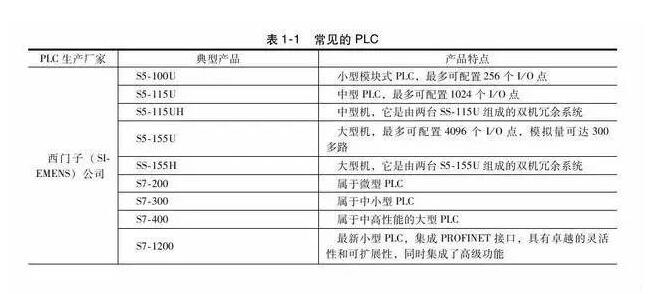
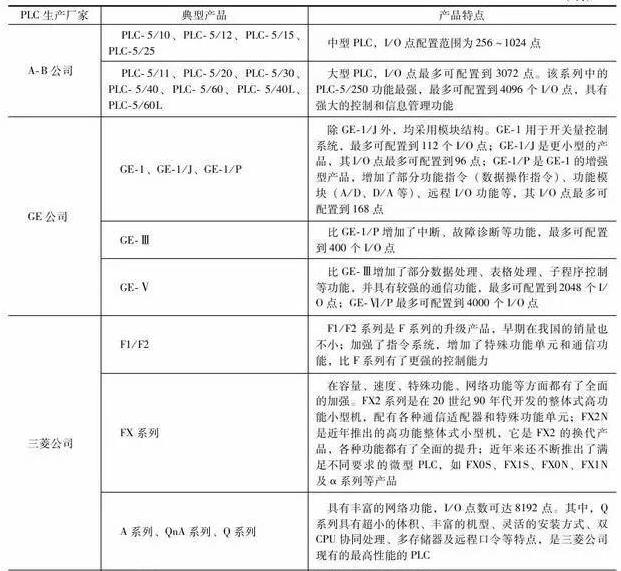

Second, PLC's functions and application areas
PLC is designed, manufactured and developed by the advantages of integrated relay contactor control and the flexibility and convenience of the computer. This makes the PLC have many features that cannot be compared with other controllers.
1.PLC function
PLC is a general-purpose industrial automatic control device which is developed by computer technology, automatic control technology and communication technology. It has high reliability, small size, strong function, simple program design, flexible and universal. It has a series of advantages such as convenient maintenance, and thus has been widely used in metallurgy, energy, chemical, transportation, electric power and other fields, and has become one of the three pillars of modern industrial control (PLC, robot and CAD/CAM). According to the characteristics of the PLC, its functional form can be classified into the following types.
(1) Switching logic control
PLC has powerful logic computing capabilities, enabling a variety of simple and complex logic control. This is the most basic and extensive application area of ​​PLC, which replaces the control of traditional relay contactors.
(2) Analog quantity control
The PLC is equipped with A/D and D/A conversion modules. The A/D module can convert the analog quantity of temperature, pressure, flow, speed, etc. in the field into a digital quantity, and then process it through the microprocessor in the PLC (the microprocessor can only process the digital quantity), and then proceed Control; or converted to analog after conversion by D/A module, and then control the controlled object, so that PLC can control the analog quantity.
(3) Process control
Modern large and medium-sized PLCs are generally equipped with PID control modules for closed-loop process control. When there is a deviation in a certain variable in the control process, the PLC can calculate the correct output according to the PID algorithm, and then control the production process to keep the variable at the setting value. Currently, many small PLCs also have PID control functions.
(4) Timing and counting control
PLC has a strong timing and counting function, it can provide users with dozens or even hundreds, thousands of timers and counters. The time and count value of the timing can be arbitrarily set by the user when writing the user program, or can be set by the operator in the industrial field through the programmer, thereby implementing timing and counting control. If the user needs to count the higher frequency signals, the high speed counting module can be selected.
(5) Sequence control
In industrial control, PLC step instruction programming or shift register programming can be used to achieve sequential control.
(6) Data processing
Modern PLCs can not only perform operations such as arithmetic operations, data transfer, sorting, and table lookup, but also perform data comparison, data conversion, data communication, data display, and printing. It has strong data processing capabilities.
(7) Communication and networking
Most modern PLCs use communication and network technology, and have RS-232 or RS-485 interfaces for remote I/O control. Multiple PLCs can be networked and communicated with each other, and program and data exchange, such as program transfer, data file transfer, monitoring, and diagnosis, can be implemented between external devices and signal processing units of one or more programmable controllers. The communication interface or communication processor completes the transfer of programs and data in accordance with standard hardware interfaces or proprietary communication protocols.
2.Application field of PLC
At present, PLC has been widely used in various industries such as steel, petroleum, chemical, electric power, building materials, machinery manufacturing, automobile, textile, transportation, environmental protection and cultural entertainment. The usage can be roughly classified into the following categories.
(1) Logic control of switching quantity
This is the most basic and widely used application area of ​​PLC. It replaces the traditional relay circuit to realize logic control and sequence control. It can be used for single device control, multi-machine group control and automatic assembly line, such as injection molding machine. , printing presses, bookbinding machines, combination machine tools, grinding machines, packaging production lines and electroplating lines.
(2) Analog quantity control
In the industrial production process, there are many continuous changes, such as temperature, pressure, flow, liquid level and speed are analog quantities. In order for the PLC to process the analog quantity, A/D conversion and D/A conversion between the analog quantity and the digital quantity must be realized. PLC manufacturers produce matching A/D and D/A conversion modules, so that PLC can be used for analog control.
(3) Motion control
The PLC can be used for the control of circular motion or linear motion. From the control mechanism configuration, the early use of the switch I/O module to connect the position sensor and the actuator, now generally uses a dedicated motion control module to drive the single or multi-axis position control module of the stepper motor or servo motor. . Almost all of the world's major PLC manufacturers have motion control functions, which are widely used in various machinery, machine tools, robots, elevators and other occasions.
(4) Process control
Process control refers to closed-loop control of analog quantities such as temperature, pressure, flow rate, etc., and has a wide range of applications in metallurgy, chemical, heat treatment, boiler control and other occasions. As an industrial control computer, PLC can program a variety of control algorithm programs to complete closed-loop control. PID regulation is a much used adjustment method in general closed-loop control systems. Large and medium-sized PLCs have PID modules. Many small PLCs also have this function module. PID processing is generally a dedicated PID subroutine.
(5) Data processing
Modern PLC has functions such as mathematical operations (including matrix operations, function operations, logic operations), data transfer, data conversion, sorting, table lookup and bit manipulation, which can complete data collection, analysis and processing. These data can be compared with reference values ​​stored in the memory to perform certain control operations; they can also be transferred to other smart devices using communication functions, or they can be printed and tabulated. Data processing is typically used in large control systems, such as unmanned flexible manufacturing systems; it can also be used in process control systems such as large control systems in the paper, metallurgical, and food industries.
(6) Communication and networking
PLC communication includes communication between PLCs and communication between PLCs and other intelligent devices. With the development of computer control, the factory automation network has developed rapidly. Each PLC manufacturer attaches great importance to the communication function of PLC and has launched their own network systems. The newly produced PLCs all have communication interfaces, and communication is very convenient. They have launched their own network systems. The newly produced PLCs all have communication interfaces, and communication is very convenient.
Third, the basic structure and working principle of PLC
As an industrial control computer, PLC and ordinary computer have similar structures; however, there are some differences in structure due to different occasions and purposes.
1. PLC hardware components
The basic block diagram of the PLC hardware system is shown in the figure.
In the figure, the host of the PLC is composed of a CPU, a memory (EPROM, RAM), an input/output unit, a peripheral I/O interface, a communication interface, and a power supply. For monolithic PLCs, these components are all in the same enclosure. For a modular PLC, each component is individually packaged, called a module, and each module is connected by a rack and a cable. Each part of the host is connected by a power bus, a control bus, an address bus and a data bus, and is equipped with certain external devices according to the needs of the actual control object to form different PLC control systems. Commonly used external devices are programmers, printers, EPROM writers, and the like. The PLC can configure the communication module to communicate with the host computer and other PLCs to form a distributed control system of the PLC.
The following describes the various components of the PLC and their functions, so that users can further understand the control principle and working process of the PLC.
(1) CPU
The CPU is the control center of the PLC, and the PLC coordinates the work in an orderly manner under the control of the CPU, thereby realizing control of each device on the site. The CPU consists of a microprocessor and a controller that can perform logical operations and mathematical operations to coordinate the control of various parts of the system.
The role of the controller is to control the various components of the entire microprocessor to work in an orderly manner. Its basic function is to read instructions and execute instructions from the memory.
(2) Memory
The PLC is equipped with two types of memory, system memory and user memory. The system memory is used to store the hypervisor, and the user cannot access and modify the contents of this part of the memory. User memory is used to store the compiled application and work data status. The portion of the user memory that holds the status of the working data, also referred to as the data memory area, includes the input/output data map area, the data area of ​​the timer/counter preset number and the current value, and the buffer that holds the intermediate result.
The memory of the PLC mainly includes the following types.
(1) Read only memory
(2) Programmable read only memory
(3) erasable programmable read only memory
(4) electrically erasable programmable read only memory
(5) Random access memory
(3) Input/Output (I/O) module
1 switch input module
Switch input devices are various switches, buttons, sensors, etc. The input type of PLC can usually be DC, AC and AC and DC. The power of the input circuit can be supplied externally, and some can also be supplied internally by the PLC.
2 switching output module
The function of the output module is to convert the control signal of the TTL level output by the CPU to the user program into a signal required by the production site to drive the specific device to drive the action of the actuator.
(4) Programmer
The programmer is an important external device of the PLC. The programmer can be used to send the user program into the user program memory of the PLC, debug the program, and monitor the execution process. The programmer can be classified into the following three types.
(1) Simple programmer
(2) Graphics programmer
(3) General Computer Programmer
(5) Power supply
The function of the power supply unit is to convert the external power supply (220V AC power supply) into an internal working voltage. The externally connected power supply converts the AC/DC power supply into the working power required by the PLC internal circuit (DC 5V, ±12V, 24V) through a dedicated switching regulator power supply inside the PLC, and is an external input component ( For example, the proximity switch) provides 24V DC power supply (for input terminals only). The power source that drives the PLC load is provided by the user.
(6) Peripheral interface
The peripheral interface circuit is used to connect a handheld programmer or other graphic programmer, text display, and can form a PLC control network through a peripheral interface. PLC uses PC/PPI cable or MPI card to connect with computer through RS-485 interface, which can realize functions such as programming, monitoring and networking.
2. PLC software composition
The PLC software consists of a system program and a user program.
The system program is designed and written by the PLC manufacturer and stored in the system memory of the PLC. The user cannot directly read, write, and change. System programs generally include system diagnostic programs, input processing programs, compiler programs, information transfer programs, and monitoring programs.
The user program of the PLC is a program that the user uses the programming language of the PLC to prepare according to the control requirements. In the application of PLC, the most important thing is to write the user program in the programming language of PLC to achieve the control purpose. Because PLC is a device specially developed for industrial control, its main users are the majority of electrical technicians. In order to meet their traditional habits and mastery, PLC's main programming language is relatively simple, easy to understand and image-specific than computer language. Language.
Graphical instruction structure
2. Clear variable constants
3. Simplified program structure
4. Simplify the application generation process
5. Strengthen the means of debugging
Third, the basic working principle of PLC
The working mode of PLC scanning is mainly divided into three stages, namely input sampling stage, user program execution stage and output refresh stage. as the picture shows.
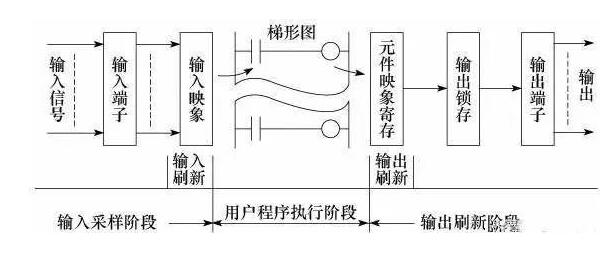
1. Input sampling stage
During the input sampling phase, the PLC reads all input states and data in a scan mode and stores them in the corresponding cells in the I/O image area. After the input sampling is finished, it is transferred to the user program execution and output refresh phase. In these two phases, the status and data of the corresponding unit in the I/O map area does not change even if the input status and data change. Therefore, if a pulse signal is input, the width of the pulse signal must be greater than one scan period to ensure that the input can be read in any case. Http://TIcle/plc/
2. User program execution phase
During the user program execution phase, the PLC always scans the user program (ladder) in order from top to bottom. When scanning each ladder diagram, the control lines formed by the contacts on the left side of the ladder diagram are always scanned first, and the control lines formed by the contacts are logically operated in the order of first left, then right, first up and then down; Then, according to the result of the logic operation, refresh the state of the corresponding bit of the logic coil in the system RAM storage area, or refresh the state of the corresponding bit of the output coil in the I/O image area, or determine whether to execute the ladder diagram Special function instructions. That is, during the execution of the user program, only the status and data of the input point in the I/O map area will not change, and the status of other output points and soft devices in the I/O map area or the system RAM storage area. And the data may change, and the ladder diagrams listed above, the program execution results will work on the ladder diagrams that use these coils or data below; on the contrary, the ladder diagrams below are The state or data of the refreshed logic coil can only be applied to the ladder diagram above it until the next scan cycle.
3. Output refresh phase
When the user program scan ends, the PLC enters the output refresh phase. During this time, the CPU refreshes all the output latch circuits according to the corresponding state and data in the I/O map area, and drives the corresponding peripherals through the output circuit. At this time, it is the real output of the PLC.
Input/output hysteresis
From the working process of the PLC, the following conclusions can be summarized.
• The program is executed in a scanning manner, and there is a principle lag in the logical relationship between the input/output signals. The longer the scan period, the more severe the lag.
The scan cycle includes the time taken by the system management operation in addition to the time taken by the three main working phases of the input sampling phase, the user program execution phase, and the output refresh phase. Among them, the execution time of the program is related to the length of the program and the complexity of the instruction operation, and the others are basically unchanged. The scan period is typically in the order of nanoseconds.
· When the program is executed for the nth scan, the input data is based on the scan value of the sampling phase in the scan period. The output data according to the scan has the output value Y(n-1) of the previous scan, and the output value of this time. Yn; The signal sent to the output terminal is the final result Yn after all the operations are performed this time.
• The input/output response lag is not only related to the scanning method, but also to the programming arrangement.
Aurora Disposable Vape Device Vaping Pod Systems
Shenzhen WeiKa Technology Co.,Ltd. is a professional e-cigarette manufacturer and enterprise integrating R&D, design, production and sales and service of the electronic cigarette atomizer products, established in 2020.
We are actively developing and producing all kinds of reliable and unique atomizer products. We centre on research, developing, high quality and safety, and focus on better vaping experience in all aspects to our customers. We have advanced production equipment and strict production control system, each process has strict management, from production to delivery have been strictly tested to ensure the classic quality. Zgarvape for the future!
Aurora E-cigarette Cartridge is loved by the majority of consumers for its gorgeous and changeable colors, especially at night or in the dark. Fruits Flavors series, plant flavors series & special flavors series.Up to 16 different flavors for choices. A new design of gradient our disposable vape is impressive. Our vape pen and pods are matched with all the brands on the market. You can use other brand's vape pen with our vape pods. Aurora series Pods systems, the first choice for professional users!
16 Available Flavors (3Pods*2ml):
Amazing Cantaloupe / Coke on the Rocks / Ice Coconut / Ice Lolly / Iced Mung Bean / Longjing Tea / Mango Feast / Mountain Spring / Peach Tempting / Pineapple Juice / Refreshing Melon / Refreshing Mint / Rich Strawberry / Rose Litchi / The Ocean / Watermelon Juice




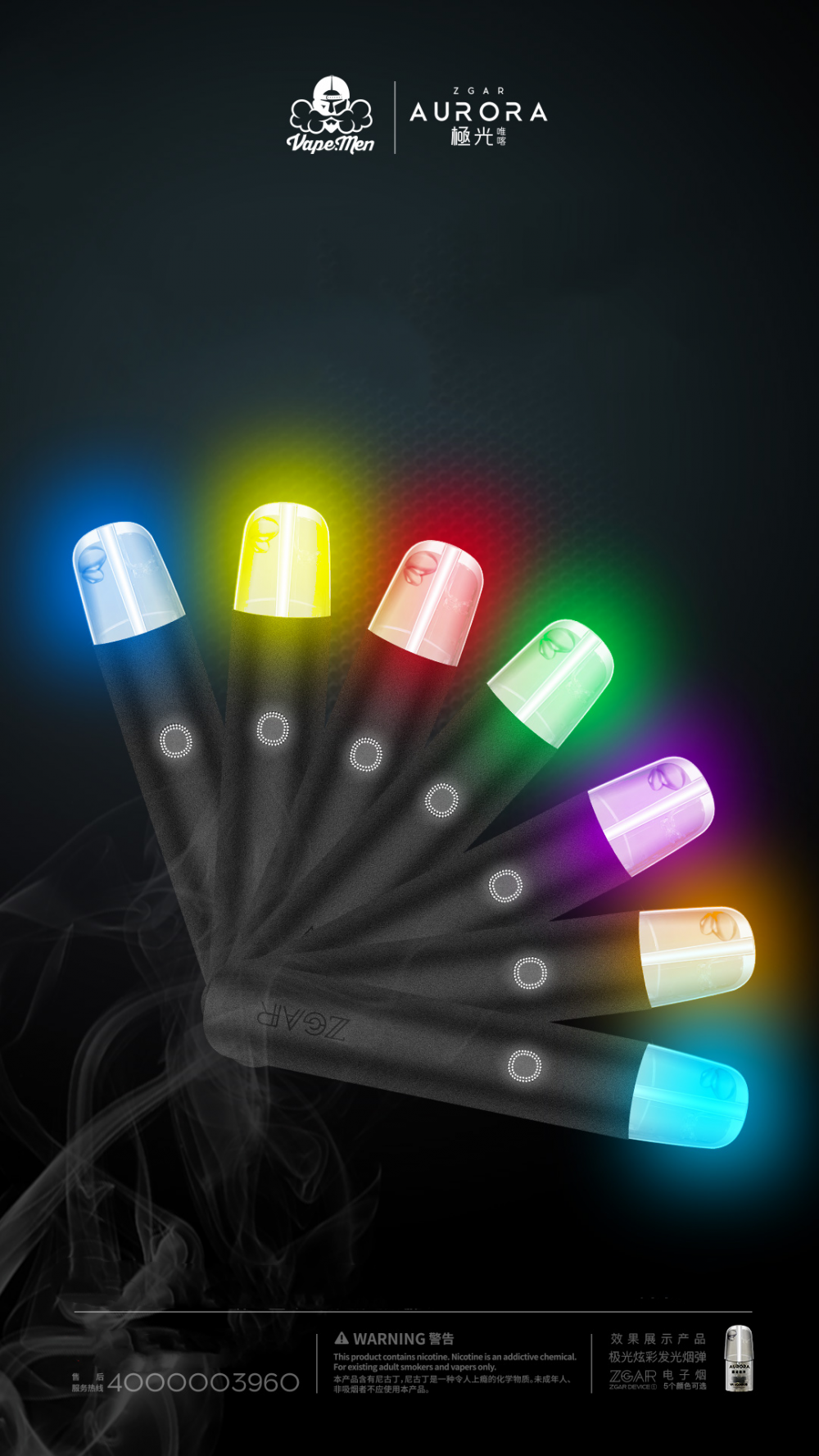
Aurora Pods 1.0,Pod System Vape,Pos Systems Touch Screen,Empty Disposable Vape Pod System,400Puffs Pod Vape System
ZGAR INTERNATIONAL(HK)CO., LIMITED , https://www.zgarette.com
